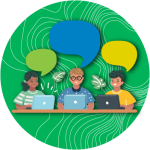The one thing I tell parents who bring their kid(s) to the Reading Help program is that reading anything is beneficial. By that, I mean it doesn’t matter whether kids read a chapter book, a graphic novel, or a picture book—reading is reading and stories are stories, no matter what form they take. What is best for struggling or reluctant readers is to find the book that makes them love reading, and if that is a series of graphic novels, then that is great! There are some fantastic stories written in the graphic novel format.
Along these lines, it is also perfectly fine for an older child to read picture books. Some picture books are quite complex with sophisticated stories or themes and are designed with older readers in mind. Stories don’t discriminate based on age, so if your ten-year-old is attracted to a picture book, then, by all means, let them read it. Adults love them too!
Picture books
Introduce hard topics in a non-threatening way—picture books are a great way to deal with difficult topics such as identity, bullying, social and racial injustice, and grief. Many picture books are written so that kids can navigate the waters of these challenging topics without feeling intimidated or overwhelmed.
Introduce kids to new cultures—pictures books can introduce kids to cultures other than their own in an inviting way. The illustrations help show the richness and diversity of the world in a way that words cannot capture as well. Kids can also discover new ways of looking at the world and all the diverse people who live in it.
Aid Young Readers through Visuals—many kids who are struggling or reluctant readers enjoy doing other things, like art. If your child expresses a dislike of reading, and is an artist, or even drawn toward the visual arts, then try picture books. Most picture books have beautiful artwork. Your young artist might appreciate how the illustrations complement the storyline.
Reading picture books can help kids understand how to interpret visuals, which is an important critical thinking skill, especially in this culture of online activities.
Reading Strategies
All of the strategies that kids can use to understand text-based books, can also be used when reading picture books. Kids can use Prediction, Asking Questions, Background Knowledge, Making Connections, and Drawing Inferences. In fact, it might be easier to understand the author’s inferences if a book has illustrations that go with the text. Also, the illustrations provide another layer of meaning to picture books, adding to what is said in the text, and it can be fun to explore those meanings with your young reader.
Because they can be less intimidating, picture books are a good way for a struggling or reluctant reader to delve into the topics from Language Arts, like understanding plot, structure, characterization, and theme. Theme can be particularly powerful in picture books, and it’s a good place for a young reader to start learning about it. For example, in the book Sugar in Milk, the beautiful illustrations complement the theme of how kindness can transcend barriers like language and culture by showing people coming together with smiles, hugs, and sharing. In this way, young readers can see the theme played out on the page. It will only aid in their understanding of theme when they read text-based books.
Real World Example
In our Reading Help program, I worked with a fourth-grade boy. He was a good reader in that he could decode words, but he needed help with comprehension. This boy did not enjoy reading fiction, so we mostly focused on reading non-fiction, like books about animals. His comprehension grew with the non-fiction we read, but he still struggled with fiction. Then, one day as we looked for a book for him to read in the chapter book section, he gravitated toward the top shelf of the picture books where we had books with their covers facing out. One had a stunning cover with vivid colors. Seeing his interest, I grabbed the book and we read it. Not only did he enjoy the story, we also studied the illustrations. As an artist, he noticed the play of colors and commented on how the illustrator not only reflected what was said in the text but added much more depth to it through visuals.
Reading the picture book was an “in” to finding a story that this particular reader enjoyed. After that, we often discussed books in terms of visuals, even when we read chapter books.
Here is a list of a few picture books that older kids might like
 Visit Learn at Home for even more great resources, including:
Visit Learn at Home for even more great resources, including:
- Free online tutoring
- Online tools available 24x7x365
- Recommended items from our collection that you can pick up curbside

